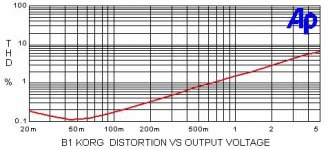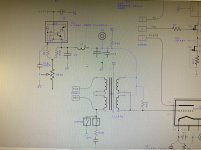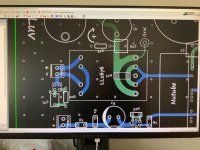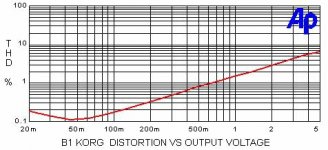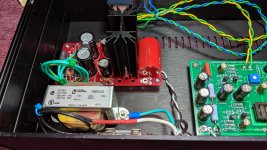Does that mean the Korg its not suitable for the TP DAC ?
I should have used a quote for reference - the F5 does not invert phase.
If a input transformer is used, I believe the impedance of the source isn't a factor. The transformer itself presents an input impedance of 40K to the source. The transformer then acts as the buffer providing a source impedance of 225R to the triode. At least that's my understanding and the nature of my question.
And as Zen Mod pointed out, if the source is not AC coupled, then an input cap would be wise to prevent DC across the primary windings.
And as Zen Mod pointed out, if the source is not AC coupled, then an input cap would be wise to prevent DC across the primary windings.
In my setup, I’m sourcing from a Apple Airport Express with an output impedance around 150R. It sounds like that would be acceptable to expose directly to the transformer, though maybe with a couple cap to handle its DC offset.
However, if I want a pot in to mix, it looks like my idea doesn’t work. I’d be better off using the original circuit and just adding the input transformer in front of it.
Thanks for the help.
However, if I want a pot in to mix, it looks like my idea doesn’t work. I’d be better off using the original circuit and just adding the input transformer in front of it.
Thanks for the help.
I was wondering if the Korg would make a suitable output stage for a Twisted Pear BIII DAC, would anyone know?
Be aware the output of the B1 Korg is limited to around 1 volt with "reasonable distortion". I don't know what sort of output the BIII has, or what you consider reasonable distortion, or how much signal your amplifier needs.
Have a look at this image taken from First Watt Article
Attachments
If a input transformer is used, I believe the impedance of the source isn't a factor. The transformer itself presents an input impedance of 40K to the source. The transformer then acts as the buffer providing a source impedance of 225R to the triode. At least that's my understanding and the nature of my question.
And as Zen Mod pointed out, if the source is not AC coupled, then an input cap would be wise to prevent DC across the primary windings.
My post #3109 made no mention of a transformer. I was suggesting doing without it. Also transformer impedances are load reflective as already pointed out.
nash
The source impedance will have a large impact on transformer performance, both
in terms of distortion and bandwidth. This is why I always use a buffer unless I
know that the source has a low Z.
What is considered low and what is high?
brian92fs,
You are going to need to float the secondaries to eliminate the coupling caps. Essentially the grid voltage becomes the ground (0V). see attached. I have not done this before so I make no promises.. this is a work progress. I have configured the LL1676 as a 1:1 with the phase inverted.
I have configured the LL1676 as a 1:1 with the phase inverted.
Dwight
You are going to need to float the secondaries to eliminate the coupling caps. Essentially the grid voltage becomes the ground (0V). see attached. I have not done this before so I make no promises.. this is a work progress.
Dwight
Attachments
Last edited:
These are some very heroic measures that you have already taken – sturdy case with one layer of dampening + additional dampening underneath and on top of the tube itself. My choice of the Naim NAC 62 as a donor chassis & support PCB with Pelican case foam underneath the B1 Korg PCB gave me a similar setup. I haven't used any magnets, though. My build has not exhibited any issues with ringing since it was completed, so I'm happy and relieved so far. The rest of the details are in post #3051. The foam rubber under the main PCB is fairly dense, while the pelican case foam is very spongey.Hi on my unit I have fixed the microphony, well 95%. If still whistles on the odd occasion.
So far I have it now is a completely enclosure, no vent holes.
Magnets at the back of the Korg.
Case panels are deadened with sound absorption. The type they use to deaden car panels.
Korg is the sitting on a sorbothane ISO anti Vibration sheet, with a strip also placed across the face of the Korg tube.
Lastly I have the Pre sitting on a small bicycle inner tube, with a 12 VDC SLA battery sitting on the cases top to further load the unit down & further damp the top plate.
So I am not sure what else I can do to fully fix the problem. However I have had one mad idea and that is to fill the cabinet with dry sand.!! There are no moving parts inside buy am unsure if it could effect the circuit over time as the sand might adsorb moisture.
...
It has been noted that some samples of the Korg tube are more susceptible to microphonics than others. Unfortunately it would seem that yours is a particularly difficult sample. It may be simpler, and possibly less expensive, to buy another Korg Nutube and try that in your preamp.
high is what is unable to ensure proper freq. response in particular situation
Being completely unequipped to measure any of this.
Does 300 ohms present as an obvious problem?
As in should I be looking at fitting a B1?
Last edited:
Is the output of the B1K 2 volts?
I bought a MiniDSP to do a crossover for a sub amp and it has you choose either a .9 or a 2 volt input sensitivity. But an additional concern is it only puts out .9 no matter what you put in. I really don't want to loose gain using it if the B1K is a 2V output.
I bought a MiniDSP to do a crossover for a sub amp and it has you choose either a .9 or a 2 volt input sensitivity. But an additional concern is it only puts out .9 no matter what you put in. I really don't want to loose gain using it if the B1K is a 2V output.
TYM, it's often best to perform simple trial-and-error when choosing the resistor value. It depends upon the applied voltage, the LED viewing angle, the LED brightness (in millicandelas), and most importantly, it depends on your preferences. How bright or how dim do you want the LED to glow? Will it operate in a brightly lit room (or outdoors)? Will it operate in a subdued light, Man Cave, dedicated listening room? Only you knows the answer to these questions, and only you can choose a resistor value which matches your specific requirements.
TYM,
To followup on Mark's point, please have a look here:
LED Current Limiting Resistors - SparkFun Electronics
Now pick an LED you like (size, colour, etc), and adjust the 'R1' resistor
to get the brightness you want. I recommend you experiment just with
the LED and resistors before you solder them in place.
Hope this helps.
Dennis
To followup on Mark's point, please have a look here:
LED Current Limiting Resistors - SparkFun Electronics
Now pick an LED you like (size, colour, etc), and adjust the 'R1' resistor
to get the brightness you want. I recommend you experiment just with
the LED and resistors before you solder them in place.
Hope this helps.
Dennis
- Home
- Amplifiers
- Pass Labs
- B1 with Korg Triode
